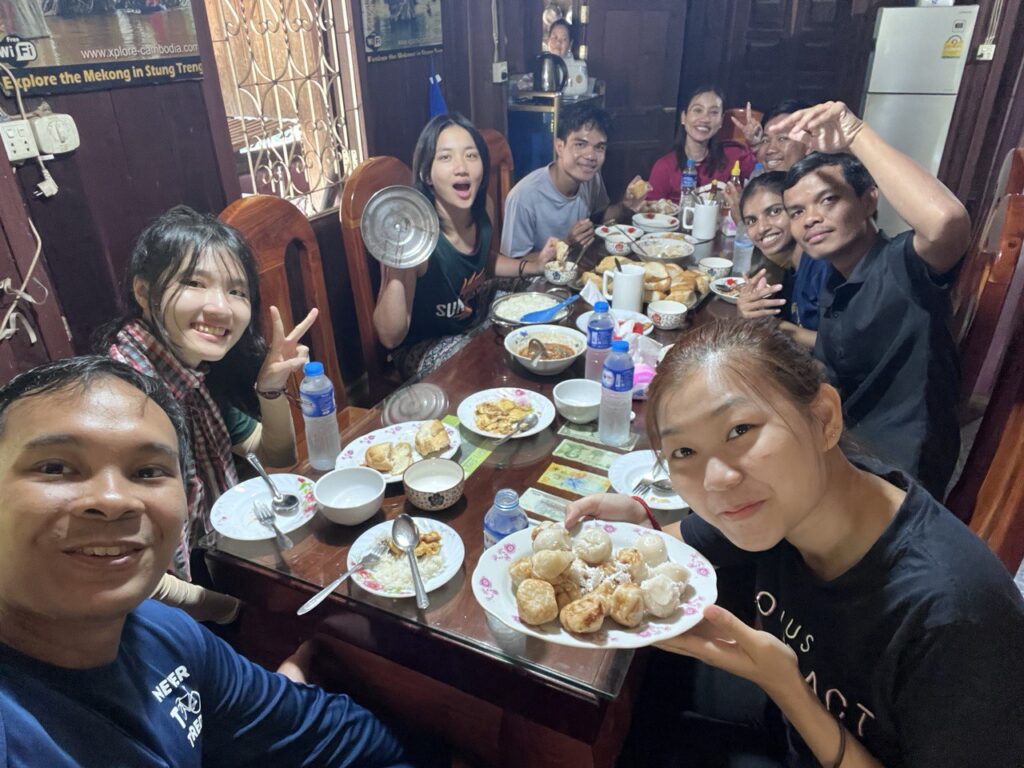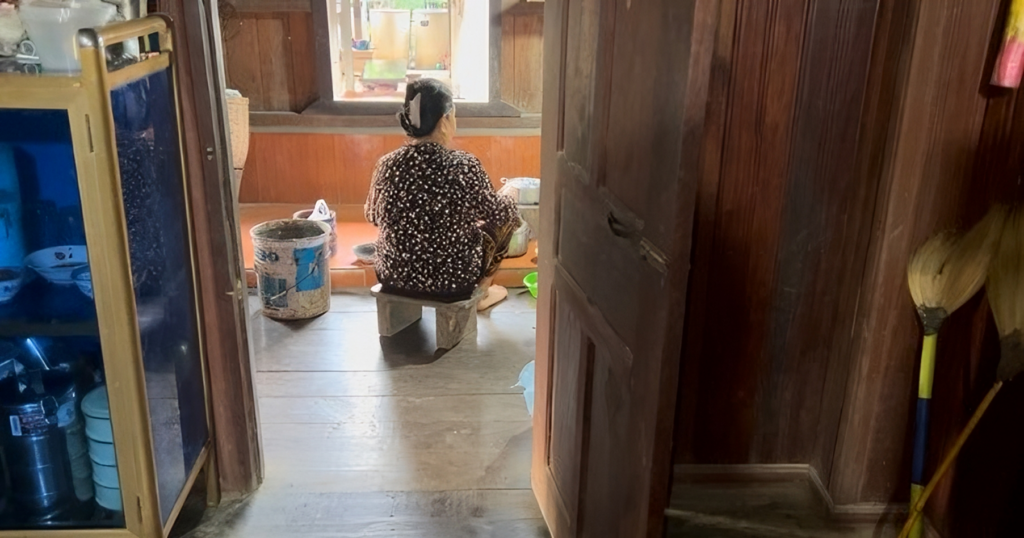Overseas Experiential Learning: Exploring Sustainability in Cambodia
March 27, 2024
Researching dolphin behaviour, studying ecotourism sustainability, and bunking at overseas homestays? That’s just a regular day in the life of geography and environmental science undergraduates at the Faculty of Arts and Social Sciences.

The GE4221HM class with the Cambodian buddies at the Mekong River in Kratie.
From 22nd September to 2nd October 2023, Dr Carl Grundy-Warr took 22 students to Cambodia to explore these areas and beyond. The course, GE4221 Field Investigation (FI) in Human Geography, had been on prolonged hiatus due to the Covid-19 pandemic and was continued this year with conservation, sustainability, and ecotourism being the main themes of focus. Let’s find out more about this unique experience through the lens of our year 4 students!
Bonds beyond Borders

Having breakfast together at the homestay. (From left to right in clockwise direction: Azhari, Zoe, Elizabeth, Mol, Sokiem, Nantana, Channea, Boon Sin)
One of the benefits of experiential learning is the opportunity to make meaningful connections with others. As part of their research adventure, the students were tasked with interviewing the Cambodian locals in Lgnor Island and Preah Rumkel. To aid them in Khmer-English translation, the students were accompanied by Cambodian buddies from Paññāsāstra University of Cambodia, Cambodia-Asia Polytechnic Institute, and Build Bright University.
Beyond crucial translation, the Cambodian buddies also introduced the NUS students, many of whom were first-time visitors to the country, to Khmer culture. “The buddies acted as a bridge between us, Cambodia, and the local people,” says Azhari.
Naturally, despite everyone’s positive demeanour, things are always a bit awkward when making new connections, especially one across borders. “Initially, communication wasn’t easy due to the language barrier,” says Elizabeth Tan. “However, these were easily overcome with sincerity from both sides to understand more about each other’s countries and life experiences.” Many of the Singapore team members shared similar anecdotes of how their buddies engaged them in late night talks, curious about our culture and excitedly sharing about their own. It is with this genuine interest and curiosity that both sides grew closer and are still in contact to this day.
Living in Homestays
Another big draw of experiential learning is the opportunity to develop new perspectives. Living in a village without shower facilities and a bunch of insects? That’s a hard pass for most of us when travelling. However, the students of this course said that they not only survived this experience but were inspired by it.

One of the homestay hostess working tirelessly in the kitchen to prepare a meal for the NUS students and their buddies
Minor inconveniences aside, the students were immensely grateful for their homestay hosts who paid careful attention to their needs and accommodated to their schedules. “Our host always catered to our schedules, even waking up early in the morning to prepare and pack our lunch on busy days when we have to spend the whole day in the field,” says Koh Hong Cheng.
Not only were their hosts kind and considerate, their actions and behaviour also reminded our homesick students of home. “I vividly remember a scene where our hostess was preparing dinner for us while her husband was watching a boxing match on television – this reminded me of home, an unpretentious experience that no hotels or resorts can ever replicate,” shares Lee Boon Sin.

The Ecotourism Group on a koyun, a tractor-driven cart. The koyun is one of the main forms of transport around Preah Rumkel alongside the motorcycle.
Perhaps most importantly, the students also gained a newfound appreciation for village life. “From riding in a tractor cart to embracing walks in the rain, I truly experienced the way of life of the local villagers here and it was different yet strangely fulfilling,” says Lu Yan Yang. “The way they work and enjoy everyday life was both humbling and inspiring, and shouldn’t be regarded as any less than the lives of city dwellers.”
Research Adventures
Let’s dive into the unique research opportunities that the students experienced on this trip.
Research 1: Questioning the Sustainability of Hydropower

The Hydropower Dams and Dolphins Group with Dr Carl Grundy-Warr and Preah Rumkel community leader Phoy Vanna behind the display of the skeletal remains of Sne at the Community-Based Ecotourism restaurant. (From left to right: Kay Yeo, Dr Carl Grundy-Warr, Phoy Vanna, Baen Sophal, Sotheareak Heang, Natalie Ong, Koh Hong Cheng)
The first of the three groups focused on uncovering the effects of the Don Sahong Hydropower Dam on the Irrawaddy Dolphin population that once inhabited the waters along the Cambodia-Laos border. Through their research of the dam and its surrounding areas, they began to uncover the impacts of harnessing hydropower, leading them to question whether hydropower is truly a sustainable source of energy.

A villager brings a dead dolphin to shore. Since the construction of Don Sahong Dam in 2016, the community had observed a significant increase in dolphin deaths along the waters of the Cambodia-Laos border
“From our interviews with locals, we learned that noise pollution associated with the construction and operation of the dam had affected the dolphin’s sensitive hearing structures,” shares Kay Yeo. “This also drove the dolphins into unprotected waters where illegal fishing was rampant, undermining their survival.” These negative impacts on the wildlife in the region cause our students to take a pause to critically reflect on our global transition and pursuit for renewable energy.
Research 2: The Ebbs and Flows of Ecotourism

The Ecotourism Group at their homestay with their buddies, host, and hostess. (From left to right: Mol, Boon Sin, homestay hostess, homestay host, Tharin, Yan Yang (Zoe), and Azhari)
While the first group studied the relationship between damns and dolphins, the second group sought to find out more about the relationship between dolphins, people, and ecotourism.
Without a doubt, the loss of the dolphin population in Preah Rumkel caused a large fall in ecotourism. “Through interaction with the locals, I learned more about their feelings of loss towards the dolphins and how that loss also economically impacted their business,” says Azhari as he reflected on the various angles of this issue.

Sopheakmit Waterfall
Apart from the Irrawaddy dolphins, the Sopheakmit waterfall is another major ecotourism attract in the area. However, this site is also subject to the ebb and flow of the dry and wet season and transitions from a majestic site to something much less spectacular. “I was surprised by the sheer volatility of ecotourism in the region,” says Boon Sin. “Upon reaching the waterfall, the site felt so abandoned and the neighbouring casino-resort had stopped all its operations, displaying the glaring lack of tourists.” This visceral experience weighed on their minds, revealing the multi-faceted nature of this problem and the impact on the locals’ livelihoods.
Research 3: Uncovering the Culture of L’Ngor Island

The group that stayed at L’ngor Island along with the homestay hosts . (From left to right: (Standing) Channea, Nantana, Homestay hosts, Guan Yu, Elizabeth, Homestay hosts; (2nd row) Father of Homestay, Sokiem, Nopy and homestay grandniece)
The third group of students studied culture and life on L’Ngor island, an island located along the Lao-Cambodian borders. Something that immediately stood out to students was the relationship the local community had with water. “Without a proper water supply system, locals rely heavily on huge rainwater tanks and pumped groundwater,” says Guan Yu. The water is used to support their everyday needs such as showering, cooking, and cleaning pots and pans.
From studying the locals’ intimate relationship with water, the students had a newfound appreciation for how readily available water is in Singapore and how we have taken it for granted. “More often than not, we are completely unaware of our water sources in Singapore,” says Guan Yu. “This was definitely a humbling experience for me”.
The Road Ahead
Overall, the 12 days spent in Cambodia were nothing short of an eye-opening experience. From seeing just how much the dams have disrupted the aquatic ecosystem to hearing firsthand how the dams have impacted the locals’ livelihood, the field studies investigation has indeed shed light in connecting what our students learned in theory to real life. “Being able to visit the places featured in our case studies reminded us just how very real and complex the issues are,” Natalie Ong shares. “It is incredibly important to hear the locals’ perspective, and this module provides one with a very special opportunity to have raw and unfiltered, hard conversations.”
The students shared that they left Cambodia with a feeling of helplessness, with the weight of loss beared by the local community now on their shoulders. Yet, they also shared that they feel empowered in wanting to do more. While the course has ended, it has nonetheless left such a deep impact in the students – with lessons that will guide them through graduation and beyond.
--- This article was written in collaboration with students from GE4221 (Ad'n Azhari B Abdul Rahman, Lee Boon Sin, Lu Yan Yang, Narendra Nath Nantana, Tan Guan Yu, Tan Junzhen, Elizabeth, Kay Yeo Hui Qin, Koh Hong Cheng, Ong Yi Ting Natalie)---

